Long-Term Monitoring of Mechanical Ventilation and Window Airing in Classrooms: A Controlled Observational Study
Abstract
1. Introduction
2. Materials and Methods
2.1. Overall Study Design
- Window Airing (WA):Four classrooms, manual window airing only, additional CO2 traffic lights;
- Decentralized (mechanical) Ventilation (DV):Two classrooms, one decentralized AHU each;
- Central (mechanical) Ventilation (CV):Two classrooms, ventilated by a central ventilation system.
2.2. Ventilation Concepts and Classrooms
2.3. Monitoring Concept and Data Acquisition
2.4. Study Period, Evaluation Period, and School-Wide Mean
2.5. Data Pre-Processing and Data Availability
2.6. Data Analysis and Statistical Inference
2.7. Acceptable Threshold Values of IEQ
3. Results
3.1. General Overview of Meteorological and Indoor Parameters
3.2. Statistical Analysis of Indoor Air Parameters
3.3. CO2 Concentrations During School Hours
3.4. Window Airing Times
3.5. Indoor and Ambient Air PM2.5 Concentrations
3.6. Indoor Environmental Quality
3.7. Decentralized Ventilation
3.8. Central Ventilation
4. Discussion
4.1. Discussion of Results
4.2. Constraints and Limitations
5. Conclusions
Author Contributions
Funding
Data Availability Statement
Acknowledgments
Conflicts of Interest
Abbreviations
| AHU | Air handling unit |
| BMS | Building management system |
| CO2 | Carbon dioxide |
| CV | Central ventilation |
| CV-off | Central ventilation with deactivated mechanical ventilation |
| CV-on | Central ventilation with activated mechanical ventilation |
| DV | Decentralized ventilation |
| DV-off | Decentralized ventilation with deactivated mechanical ventilation |
| DV-on | Decentralized ventilation with activated mechanical ventilation |
| IAQ | Indoor air quality |
| IEQ | Indoor environmental quality |
| PM | Particulate matter |
| ppm | Parts per million |
| r.h. | Relative humidity |
| T | Indoor air temperature |
| VOC | Volatile organic compounds |
| VPN | Virtual private network |
| WA | Window airing |
| WCS | Window contact switch |
References
- Birmili, W.; Brinkmann, M.M.; de Graaf, D.; Herr, C.; Moriske, H.-J.; Neisel, F.; Plehn, W.; Selinka, H.-C.; Scherer, C.; Straff, W.; et al. Das Risiko einer Übertragung von SARS-CoV-2 in Innenräumen lässt sich Durch Geeignete Lüftungsmaßnahmen Reduzieren: Stellungnahme der Kommission Innenraumlufthygiene am Umweltbundesamt (Stand: 12 August 2020); Umweltbundesamt: Dessau-Roßlau, Germany, 2020. [Google Scholar]
- Al horr, Y.; Arif, M.; Katafygiotou, M.; Mazroei, A.; Kaushik, A.; Elsarrag, E. Impact of indoor environmental quality on occupant well-being and comfort: A review of the literature. Int. J. Sustain. Built Environ. 2016, 5, 1–11. [Google Scholar] [CrossRef]
- German Environment Agency. Gesundheitliche Bewertung von Kohlendioxid in der Innenraumluft: Mitteilungen der Ad-hoc-Arbeitsgruppe Innenraumrichtwerte der Innenraumlufthygiene-Kommission des Umweltbundesamtes und der Obersten Landesgesundheitsbehörden. Bundesgesundheitsblatt 2008, 51, 1358–1369. [Google Scholar] [CrossRef] [PubMed]
- VDI 6040 Part 1 (2011-06-00); Air-Conditioning—Schools—Requirements (VDI Ventilation Code of Practice, VDI Code of Practice for School Buildings). VDI-Gesellschaft Bauen und Gebäudetechnik: Düsseldorf, Germany, 2011.
- Hartmann, A.; Cetin, Y.E.; Gastmeier, P.; Kriegel, M. Praktische Bedeutung von CO2 als Indikator für die Innenraumluftqualität und die relative inhalierte Dosis virenbeladener Partikel. Epid. Bull. 2024, 8, 3–7. [Google Scholar] [CrossRef]
- Wargocki, P.; Porras-Salazar, J.A.; Contreras-Espinoza, S.; Bahnfleth, W. The relationships between classroom air quality and children’s performance in school. Build. Environ. 2020, 173, 106749. [Google Scholar] [CrossRef]
- Wargocki, P.; Wyon, D.P. Providing better thermal and air quality conditions in school classrooms would be cost-effective. Build. Environ. 2013, 59, 581–589. [Google Scholar] [CrossRef]
- König, J. Lüftungskonzepte in Bildungsstätten—Einfluss der Luftqualität auf die Leistungsfähigkeit von Schülern. Sep. 2015. Available online: https://www.semanticscholar.org/paper/L%C3%BCftungskonzepte-in-Bildungsst%C3%A4tten-Einfluss-der-K%C3%B6nig/cdcb6250f23b08998044dc21bfc51ff189b6fee5 (accessed on 9 April 2025).
- Jendrossek, S.N.; Jurk, L.A.; Remmers, K.; Cetin, Y.E.; Sunder, W.; Kriegel, M.; Gastmeier, P. The Influence of Ventilation Measures on the Airborne Risk of Infection in Schools: A Scoping Review. Int. J. Environ. Res. Public Health 2023, 20, 3746. [Google Scholar] [CrossRef] [PubMed]
- Knaus, C.; Hartmann, T.; Spitzner, M.H. Grundlagen- und Konzeptentwicklung für die Analyse von Praxisgerechten Lüftungskonzepten bei Mechanischer oder Fensterlüftung. Zukunft Bau Final Report 10.08.17.7-16.33; im Auftrag des Bundesinstitutes für Bau, Stadt- und Raumforschung (BBSR): Bonn, Germany, 2017. [Google Scholar]
- Duill, F.F.; Schulz, F.; Jain, A.; Paucke, N.; Van Wachem, B.; Beyrau, F. Analysis of IAQ in classrooms during COVID-19 pandemic and the effect of window ventilation and air cleaners depending on season. Build. Environ. 2025, 270, 112484. [Google Scholar] [CrossRef]
- Schilling, M.; Pelster, S.; Jelden, T.; Schlegel, E.; Mumme, J.; Ciric, D. Air quality monitoring survey in german school classrooms during the COVID-19 pandemic 2021. arXiv 2022, arXiv:2203.13500. [Google Scholar]
- Azuma, K.; Yanagi, U.; Kagi, N.; Kim, H.; Ogata, M.; Hayashi, M. Environmental factors involved in SARS-CoV-2 transmission: Effect and role of indoor environmental quality in the strategy for COVID-19 infection control. Environ. Health Prev. Med. 2020, 25, 66. [Google Scholar] [CrossRef] [PubMed]
- REHVA. REHVA COVID-19 Guidance Document, August 3, 2020: How to Operate HVAC and Other Building Service Systems to Prevent the Spread of the Coronavirus (SARS-CoV-2) Disease (COVID-19) in Workplaces; Federation of European Heating, Ventilation and Air Conditioning Associations: Brussels, Belgium, 2020. [Google Scholar]
- Morawska, L.; Allen, J.; Bahnfleth, W.; Bluyssen, P.M.; Boerstra, A.; Buonanno, G.; Cao, J.; Dancer, S.J.; Floto, A.; Franchimon, F.; et al. A paradigm shift to combat indoor respiratory infection. Science 2021, 372, 689–691. [Google Scholar] [CrossRef] [PubMed]
- BTGA. BTGA Praxisleitfaden: Planung und Betrieb von RLT-Anlagen bei Erhöhten Infektionsschutzanforderungen; BTGA—Bundesindustrieverband Technische Gebäudeausrüstung e. V.: Bonn, Germany, 2021. [Google Scholar]
- FGK. FGK-Status-Report 52: Anforderungen an Lüftung und Luftreinigung zur Reduktion des Infektionsrisikos über den Luftweg—AHA + Lüftung; Fachverband Gebäude-Klima e. V.: Bietigheim-Bissingen, Germany, 2021. [Google Scholar]
- German Environment Agency. Lüften in Schulen: Empfehlungen des Umweltbundesamtes zu Luftaustausch und effizientem Lüften zur Reduzierung des Infektionsrisikos durch Virushaltige Aerosole in Schulen; Umweltbundesamt: Dessau-Roßlau, Germany, 2020. [Google Scholar]
- German Environment Agency. Richtig Lüften in Schulen. Umweltbundesamt. Available online: https://www.umweltbundesamt.de/richtig-lueften-in-schulen (accessed on 21 October 2024).
- German Environment Agency. Lüftung, Lüftungsanlagen und Mobile Luftreiniger an Schulen. Umweltbundesamt. Available online: https://www.umweltbundesamt.de/themen/lueftung-lueftungsanlagen-mobile-luftreiniger-an (accessed on 29 July 2025).
- Themenseite: Allgemeinbildende Schulen. Statista. Available online: https://de.statista.com/themen/250/schule/ (accessed on 9 April 2025).
- FGK e. V.—Pressemitteilungen. Available online: https://updates.fgk.de/presseverwaltung/pm-ausgabe-mit-rahmen.php?index=237 (accessed on 9 April 2025).
- OL0119-G2 CO2 Ampel Datasheet v4; OPTO4L GmbH: Schönecken, Germany, 2021.
- Betriebsanleitung Comfort Grossraum Lüftung CGL edu. Wolf GmbH. Available online: https://www.wolf.eu/de-de/professional/downloads/downloadcenter?selection=CGL%7Ctype_instruction%7Ctag_%23CGL (accessed on 29 April 2025).
- TROX AIR PURIFIERS, TAP-L, TAP-M, Operating Instructions, GB/en. TROX GmbH. Available online: https://cdn.trox.de/f62a9db3117ae2de/16f12913feb3/TAP_OM_V4_A00000083746_2020_11_GB_en.pdf (accessed on 29 April 2025).
- EN 16798-1:2019; Energy Performance of Buildings—Ventilation for Buildings—Part 1: Indoor Environmental Input Parameters for Design and Assessment of Energy Performance of Buildings Addressing Indoor Air Quality, Thermal Environment, Lighting and Acoustics—Module M1-6. Beuth Verlag GmbH: Berlin, Germany, 2022. [CrossRef]
- SchulbauV: Schulbauverordnung (SchulbauV) Vom 30. Dezember 1994 (GVBl 1995 S. 61) BayRS 2230-1-1-3-K (§§ 1–7)—Bürgerservice. Available online: https://www.gesetze-bayern.de/Content/Document/BaySchulBauV (accessed on 6 December 2024).
- Datasheet of Multi Sensor Measurement Device FS1600. FuehlerSysteme eNET International GmbH. Available online: https://www.fuehlersysteme.de/mediafiles/DataSheets/Datasheet_EN_FS1600.pdf?srsltid=AfmBOoo4gqVbKqIvf0S2TAJTi8xPUOXAN9dxO7ItWM7HLj_J2L-7zAMg (accessed on 8 April 2025).
- Datasheet of Particulate Matter Sensor FS1308. FuehlerSysteme eNET International GmbH. Available online: https://snuevo.de/mediafiles/DataSheets/Datasheet_EN_FS1308.pdf (accessed on 8 April 2025).
- Datasheet of Multi Weather Sensor u[sonic]WS7. LAMBRECHT Meteo GmbH. Available online: https://www.lambrecht.net/upload/productDocuments/u[sonic]WS7_Multi%20parameter%20sensor_Datasheet_2.pdf (accessed on 8 April 2025).
- Datasheet of Electrical Current Transformer AT 10 B5. LEM International SA. Available online: https://www.lem.com/sites/default/files/products_datasheets/at-b10.pdf (accessed on 8 April 2025).
- Umweltbundesamt. Anforderungen an Lüftungskonzeptionen in Gebäuden—Teil I: Bildungseinrichtungen. Empfehlungen des Arbeitskreis Lüftung (AK Lüftung) am Umweltbundesamt; Umweltbundesamt: Dessau-Roßlau, Germany, 2017. [Google Scholar]
- The MathWorks Inc. MATLAB, Version: 23.2.0 (R2023b); The MathWorks Inc: Natick, MA, USA, 2023; Available online: https://www.mathworks.com (accessed on 29 July 2025).
- The MathWorks Inc. MATLAB, Version: 24.2.0 (R2024b); The MathWorks Inc: Natick, MA, USA, 2024; Available online: https://www.mathworks.com (accessed on 29 July 2025).
- The MathWorks Inc. Statistics and Machine Learning Toolbox, Version: 23.2 (R2023b); The MathWorks Inc: Natick, MA, USA, 2023; Available online: https://de.mathworks.com/products/statistics.html (accessed on 2 September 2025).
- German Environment Agency. Feinstaub. Umweltbundesamt. Available online: https://www.umweltbundesamt.de/themen/luft/luftschadstoffe-im-ueberblick/feinstaub (accessed on 30 October 2024).
- World Health Organization. WHO Global Air Quality Guidelines. Particulate Matter (PM2.5 and PM10), Ozone, Nitrogen Dioxide, Sulfur Dioxide and Carbon Monoxide. Executive Summary; World Health Organization: Geneva, Switzerland, 2021. [Google Scholar]
- German Environment Agency. Flüchtige Organische Verbindungen. Umweltbundesamt. Available online: https://www.umweltbundesamt.de/themen/gesundheit/umwelteinfluesse-auf-den-menschen/chemische-stoffe/fluechtige-organische-verbindungen (accessed on 28 October 2024).
- Albers, K.-J.; Recknagel, H.; Sprenger, E. Taschenbuch für Heizung und Klimatechnik 2019/2020: Einschließlich Trinkwasser- und Kältetechnik sowie Energiekonzepte, 79th ed.; ITM InnoTech Medien GmbH: Augsburg, Germany, 2019; Volume 1 + 2. [Google Scholar]
- Frank, W. Raumklima und Thermische Behaglichkeit Berichte aus der Bauforschung; Berlin-München-Düsseldorf; Wilhelm Ernst & Sohn KG: Berlin, Germany, 1975. [Google Scholar]
- FGK. FGK-Status-Report 58—Anforderungen an die Raumluftfeuchtigkeit zur Reduktion des Infektionsrisikos über den Luftweg AHA + L + Feuchte; Fachverband Gebäude-Klima e. V.: Bietigheim-Bissingen, Germany, 2022. [Google Scholar]

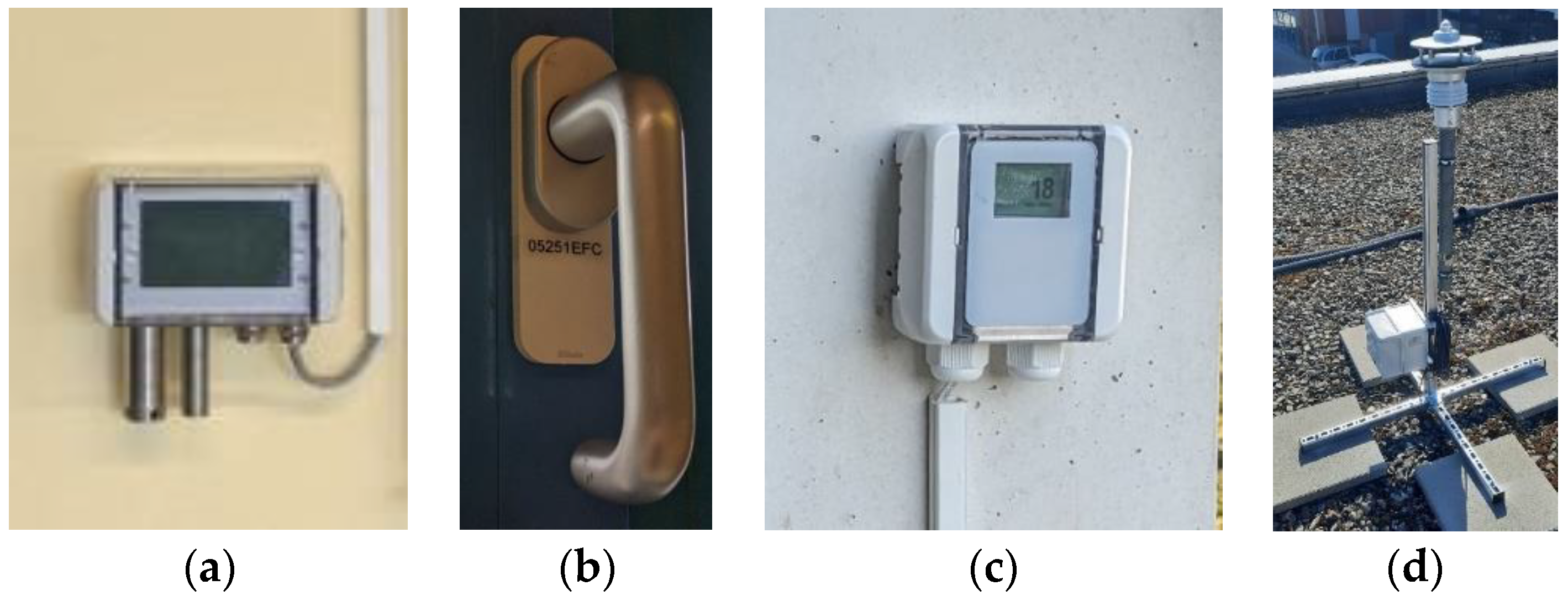
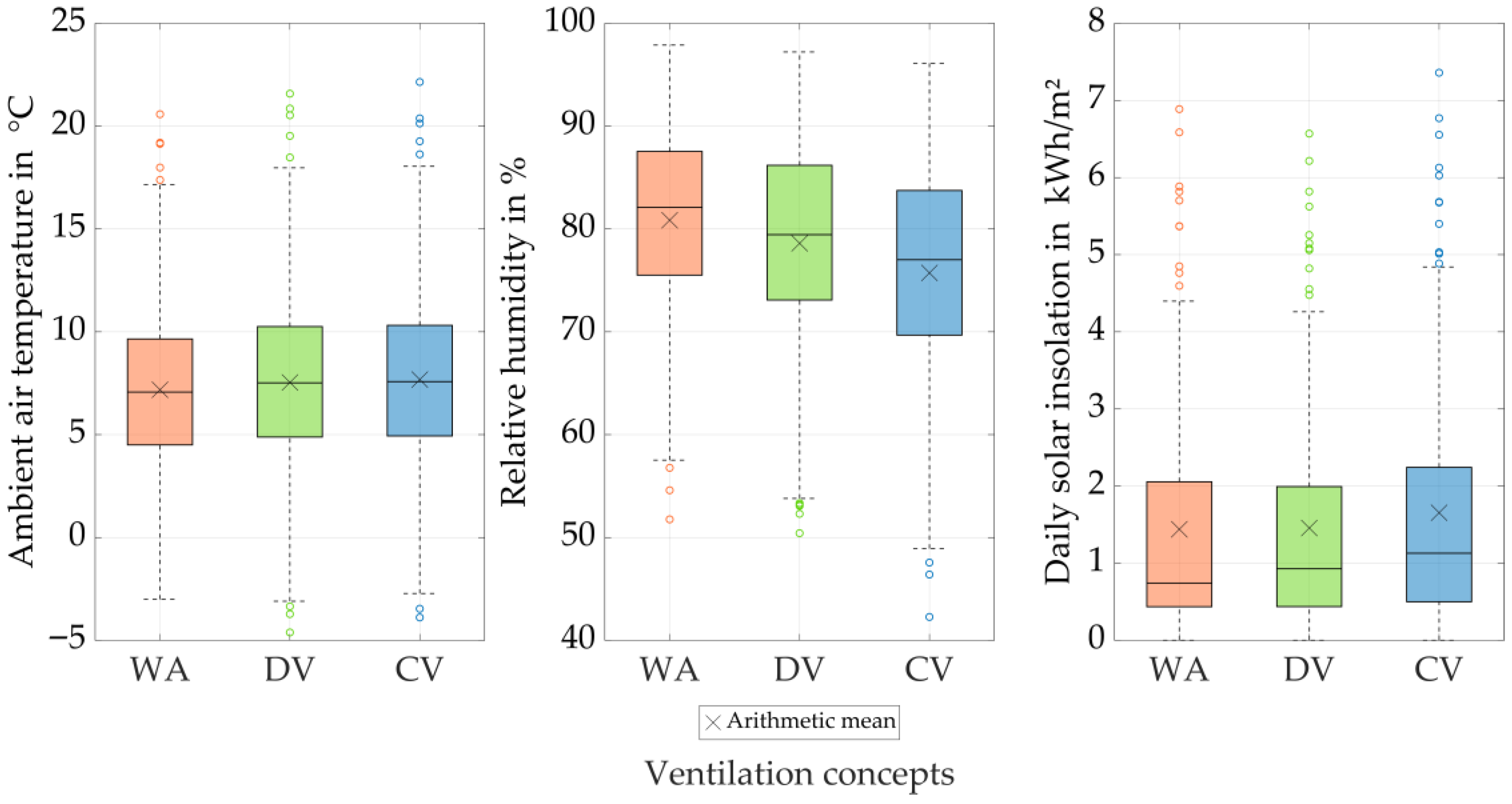


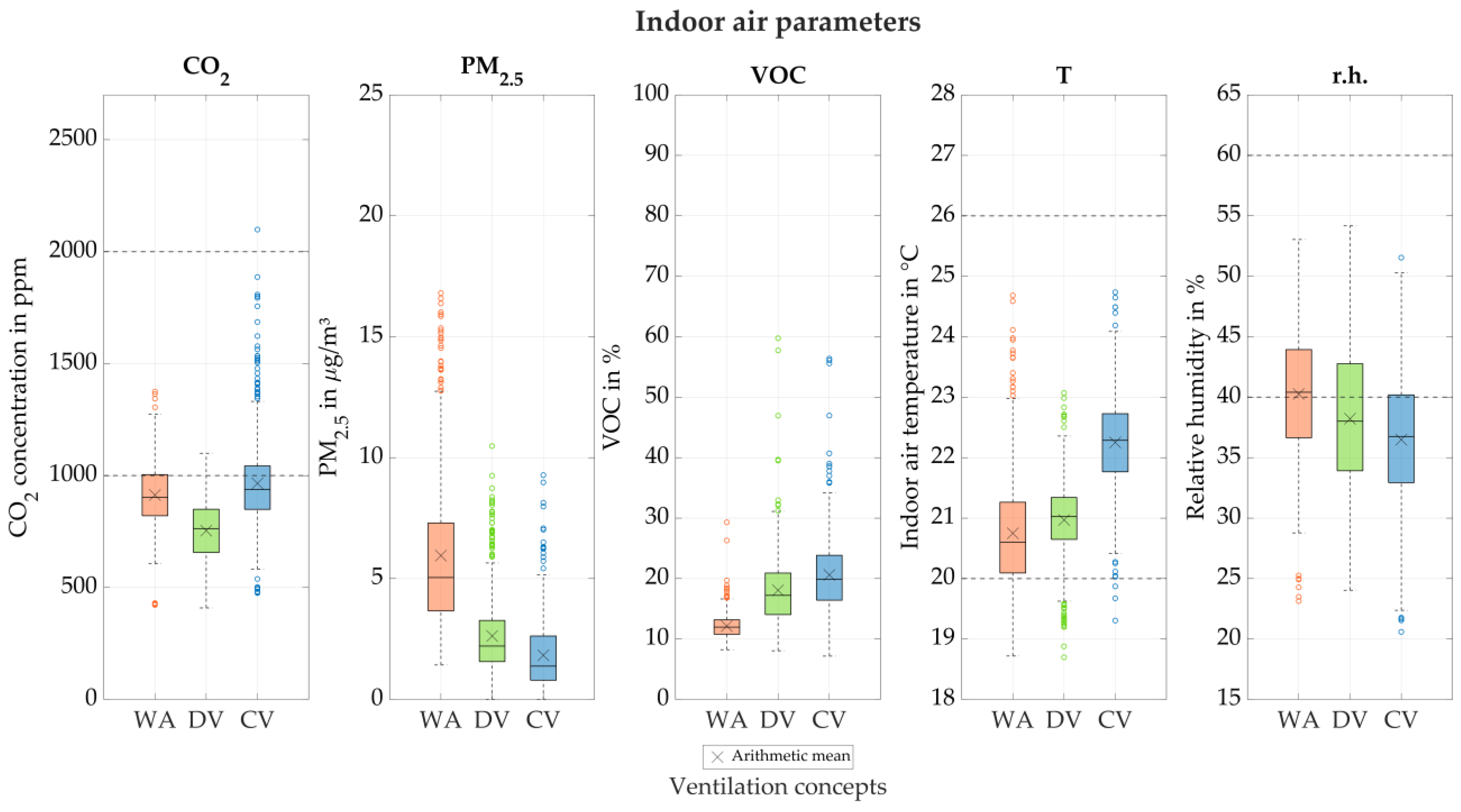
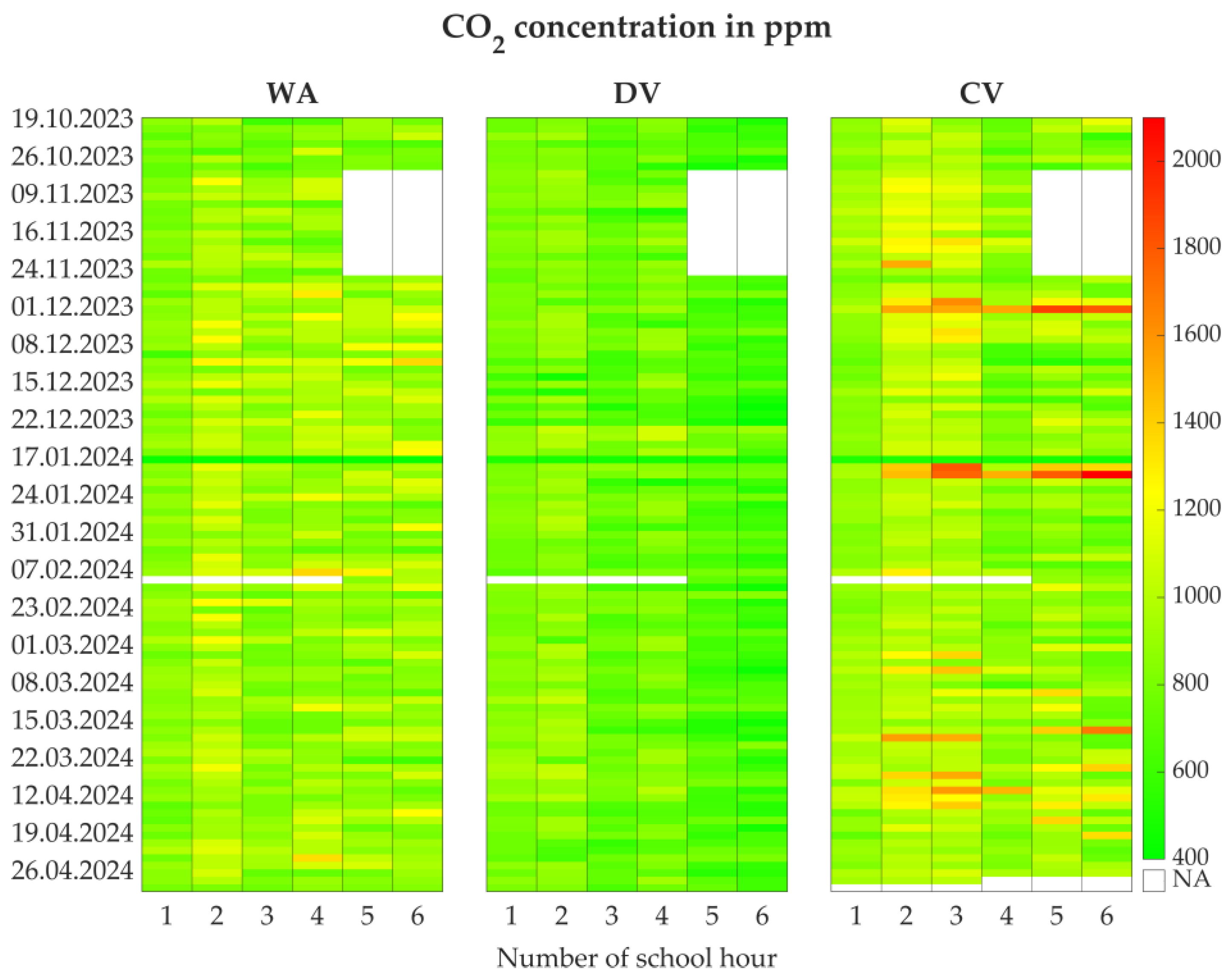

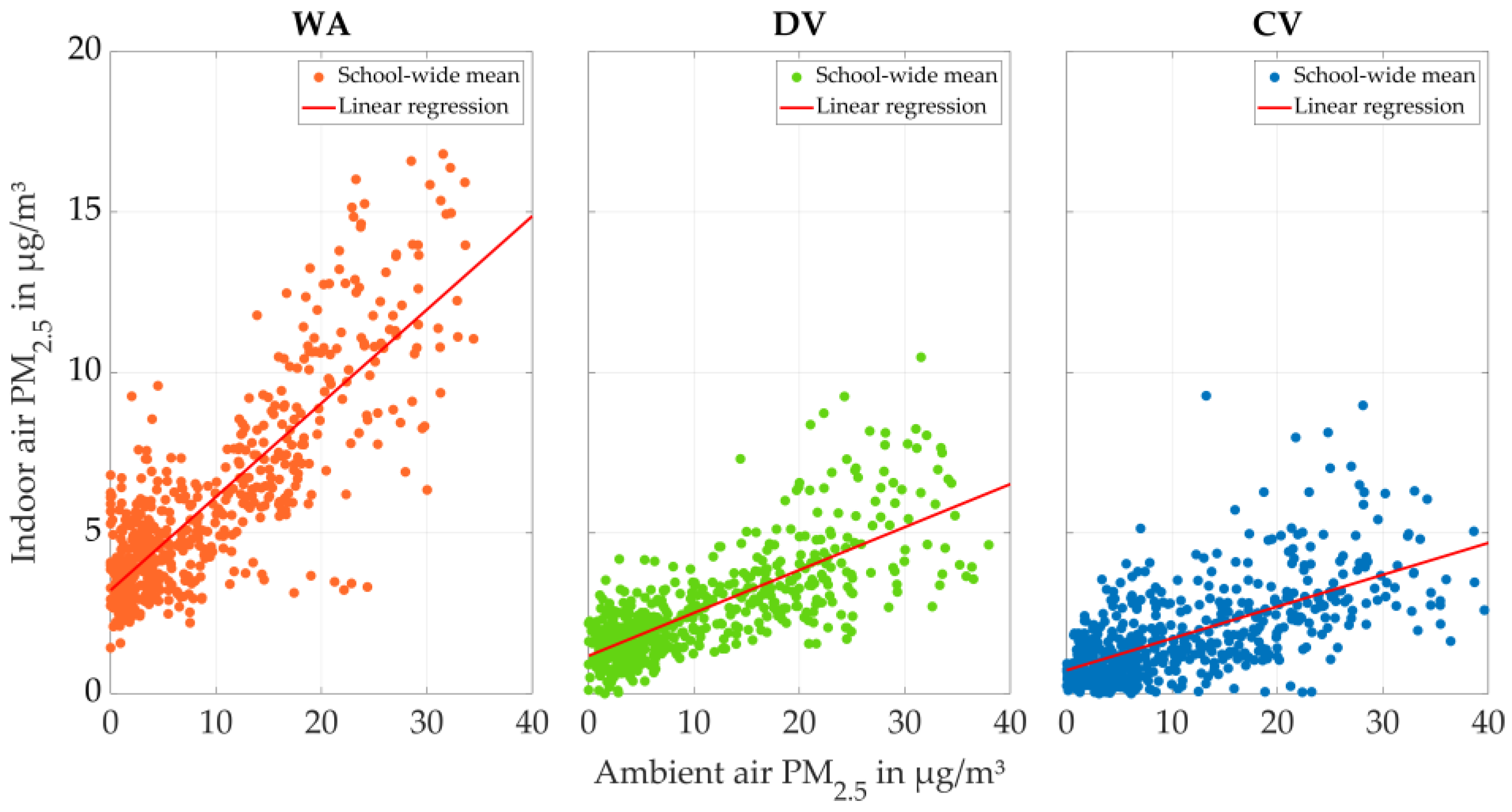

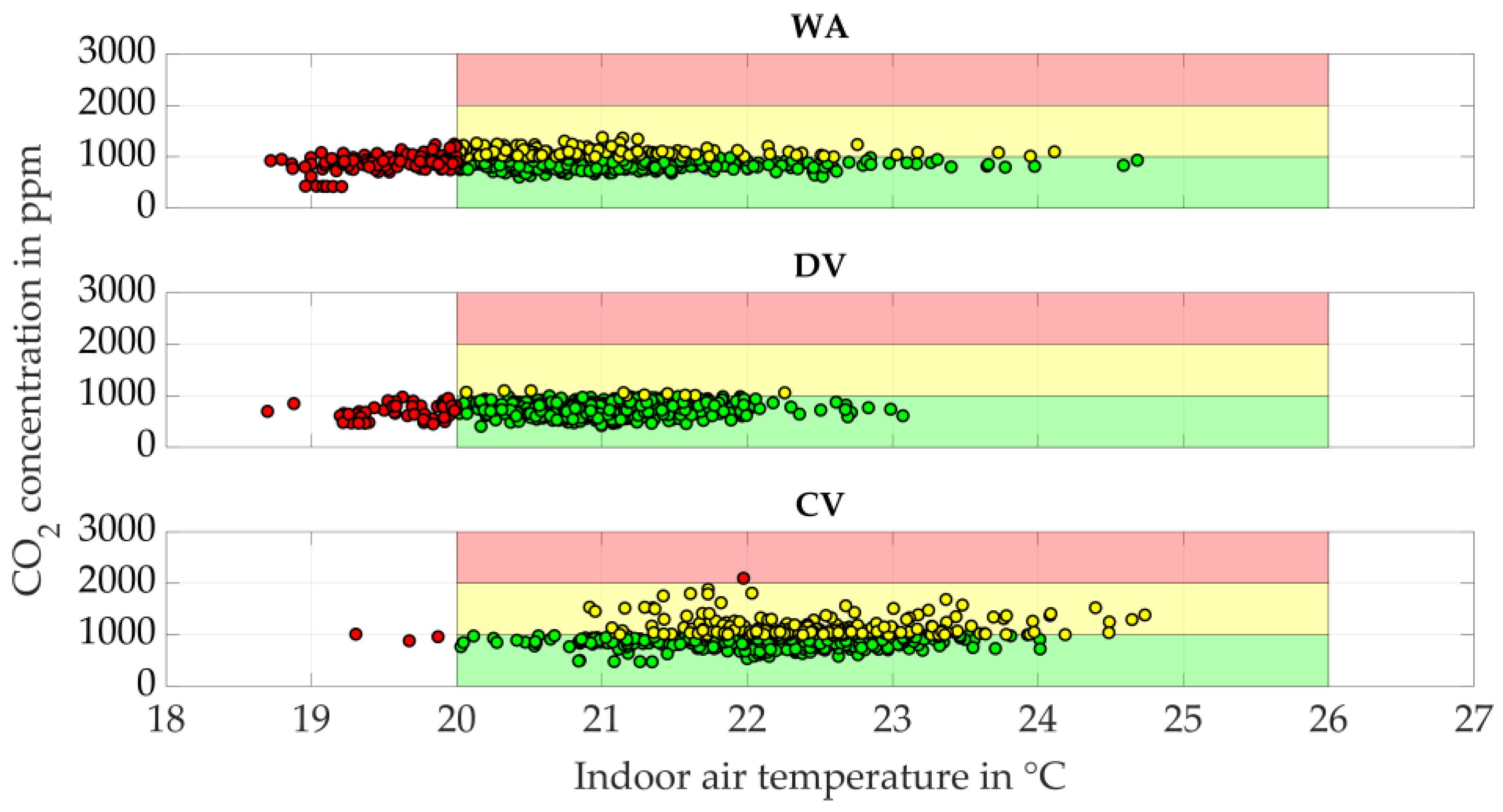
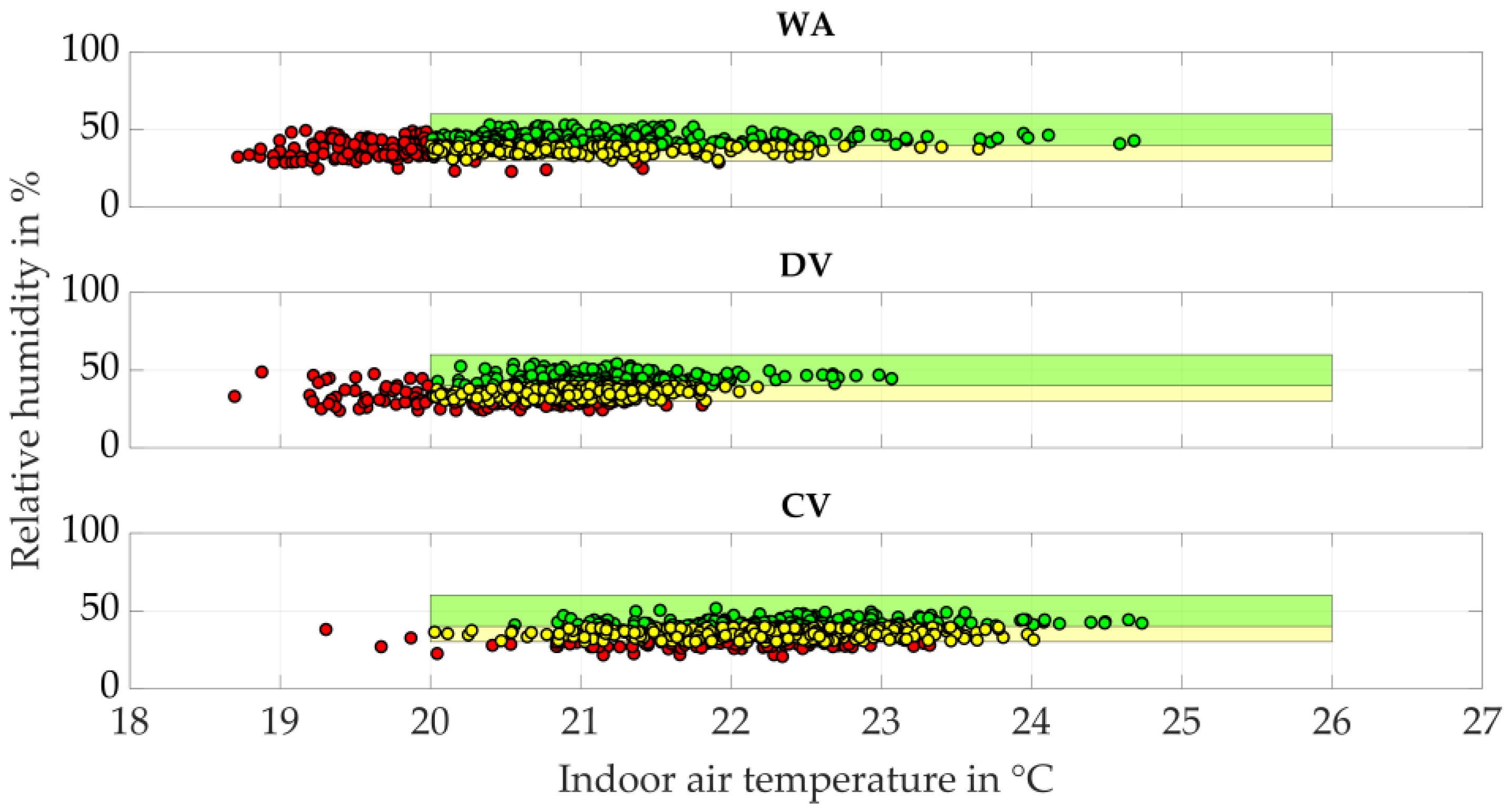
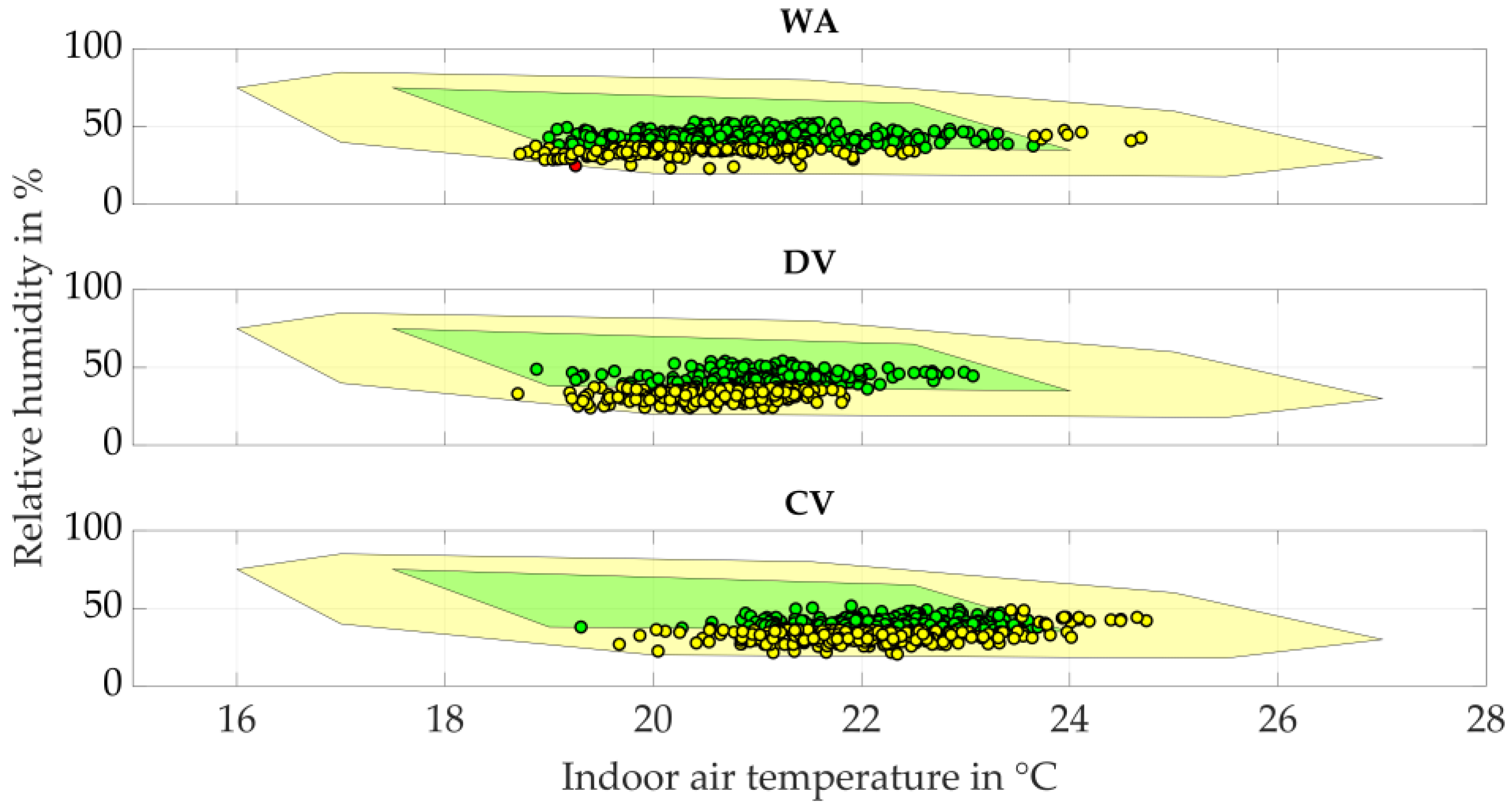
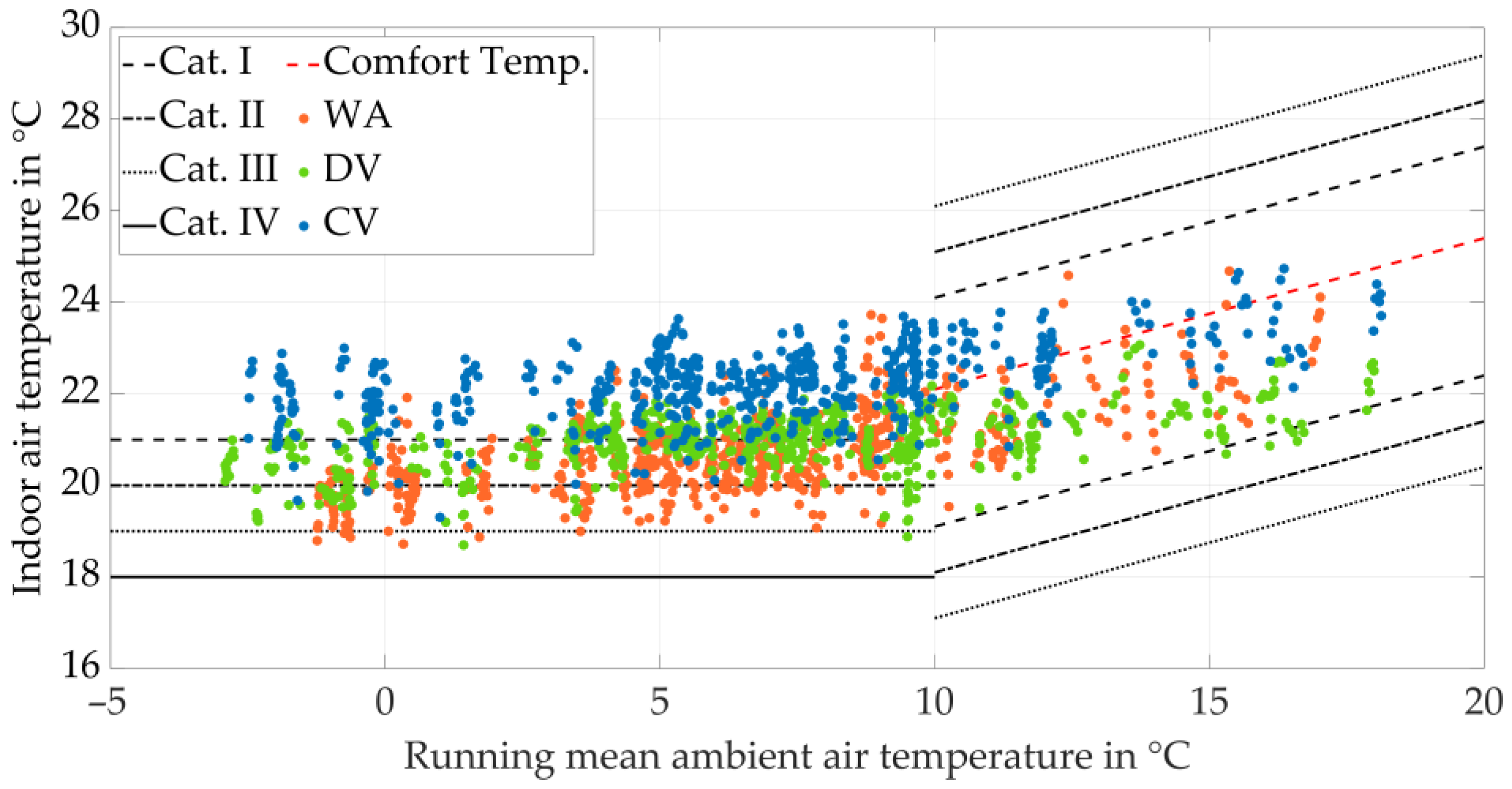
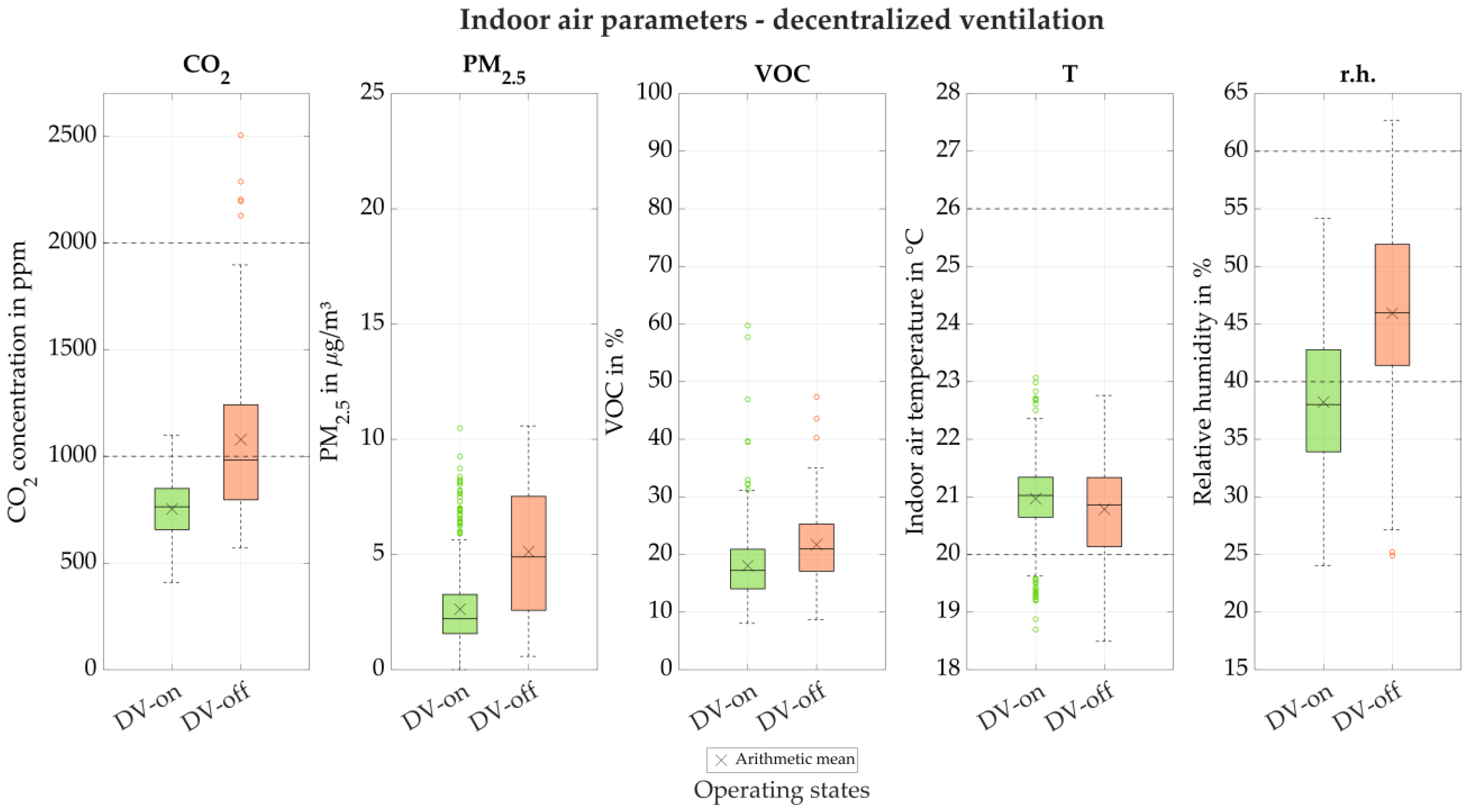
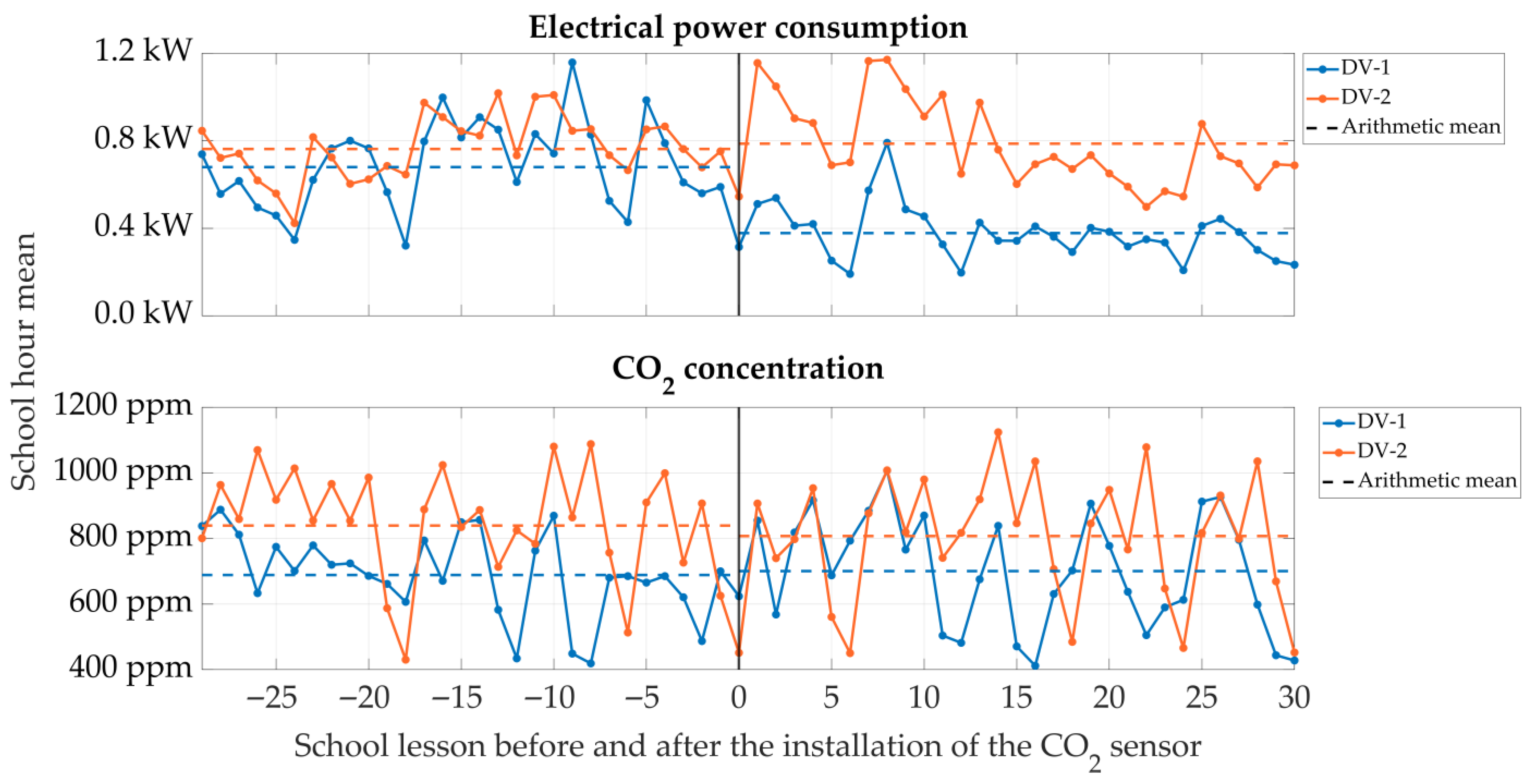
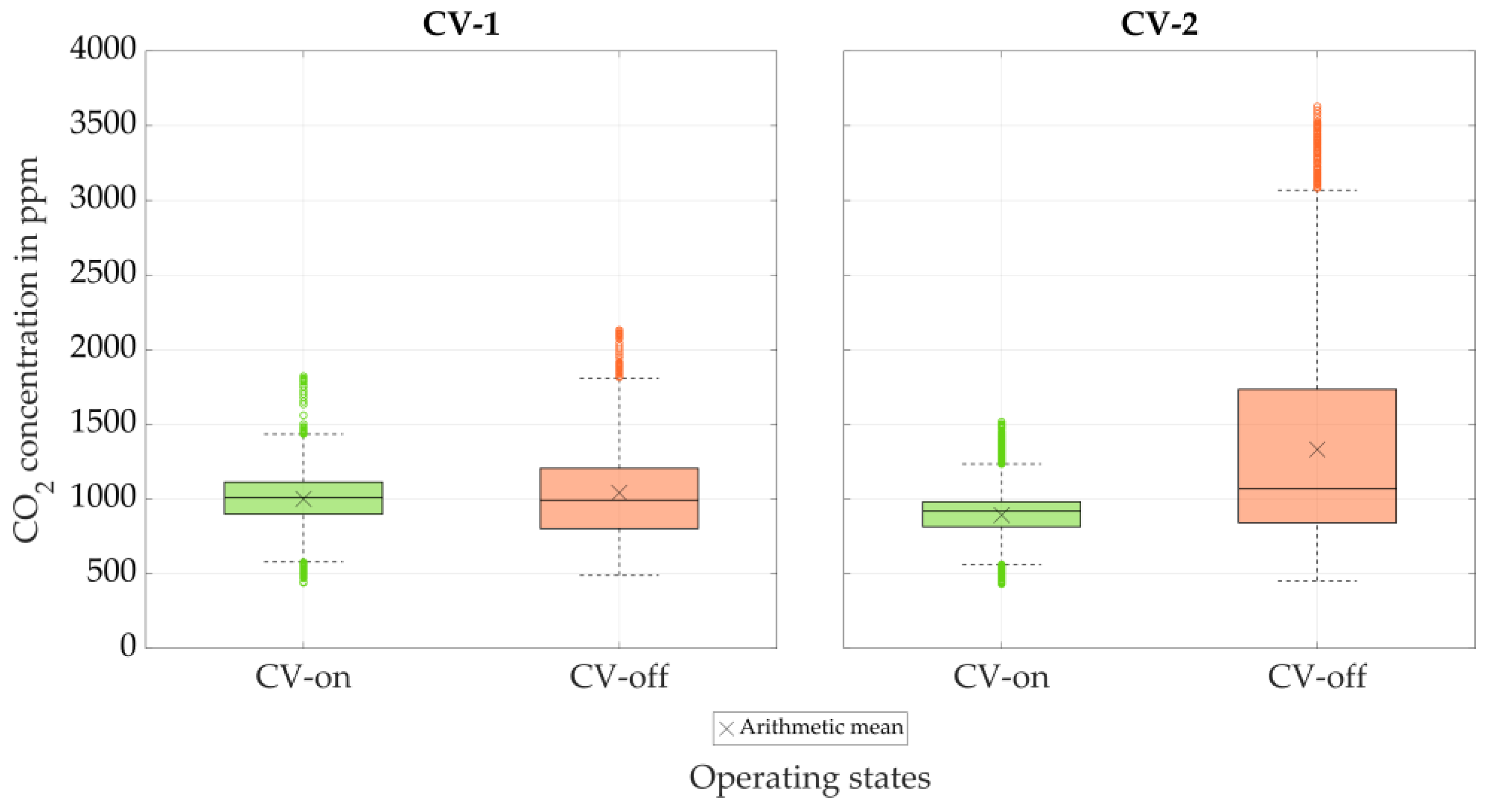
| Classroom | ||||||||
|---|---|---|---|---|---|---|---|---|
| Properties | WA-1 | WA-2 | WA-3 | WA-4 | DV-1 | DV-2 | CV-1 | CV-2 |
| Length (m) | 10.7 | 8.50 | 8.8 | 9.1 | ||||
| Width (m) | 6.7 | 7.0 | 7.0 | |||||
| Height (m) | 3.2 | 3.0 | 3.0–4.65 | 3.0 | ||||
| Floor area (m2) | 71.7 | 59.5 | 61.6 | 63.7 | ||||
| Volume (m3) | 225.8 | 178.5 | 228.8 | 177.5 | 188.3 | |||
| Number of openable windows | 3 | 6 | 5/1 | 4 | ||||
| Window type | sliding windows | t-t | t-t/door | t-t | ||||
| Orientation | south (180°) | east (90°) | north–northeast (15°) | |||||
| Solar shading | fixed structural | operable external/fixed structural | operable external | |||||
| Heating system | wall mounted radiators (mc) | wall mounted radiators (mc) | underfloor heating (cc) | |||||
| Year of construction | 1974 | 1994 | 2016 | |||||
| Classroom | ||||||||
|---|---|---|---|---|---|---|---|---|
| Properties | WA-1 | WA-2 | WA-3 | WA-4 | DV-1 | DV-2 | CV-1 | CV-2 |
| Occupants | 23 | 20 | 25 | 23 | 22 | 26 | 23 | 20 |
| Specific area (m2/person) | 3.1 | 3.6 | 2.9 | 3.1 | 2.7 | 2.3 | 2.7 | 3.2 |
| Specific volume (m3/person) | 9.8 | 11.3 | 9.0 | 9.8 | 8.1 | 8.8 | 7.7 | 9.4 |
| qtot (perceived air quality) (m3/h) | 760 | 685 | 811 | 760 | 704 | 805 | 735 | 665 |
| Sensor Type | Location | Measurement Parameter | Measurement Range | Accuracy | Source |
|---|---|---|---|---|---|
| Multi-sensor device | Indoor | Air temperature | −20–+50 °C | ±0.5 K | [28] |
| Relative humidity | 0–100% r.h. | ±3% r.h. | |||
| CO2 concentration | 0–10,000 ppm | ±50 ppm | |||
| PM2.5 | 0–1000 µg/m3 | ±5 µg/m3 | |||
| VOC | 0–100% | <10% | |||
| Particulate matter sensor | Outdoor | PM2.5 | 0–1000 µg/m3 | ±5 µg/m3 | [29] |
| Weather station | Outdoor | Ambient air temperature | −40–+70 °C | ±0.1 K | [30] |
| Relative humidity | 0–100% r.h. | ±1.5% r.h. | |||
| Ambient air pressure | 300–1100 hPa | ±0.5 hPa | |||
| Solar irradiance | 0–2000 W/m2 | <20 W/m2 | |||
| Wind speed | 0–65 m/s | ±0.2 m/s | |||
| Wind direction | 0–360° | <2° | |||
| Current transformer | Indoor | Electrical current | 0–10 A | <0.15 A | [31] |
| Parameter | Lower Threshold | Upper Threshold | Literature Source |
|---|---|---|---|
| CO2 concentration | - | 1000 ppm/2000 ppm | [3,4] |
| PM2.5 | - | 15 µg/m3/d | [37] |
| Indoor air temperature | 20 °C | 26 °C | [26] |
| Relative humidity (r.h.) | 30% r.h./40% r.h. | 60% r.h. | [26,41] |
| Descriptive | CO2 | PM2.5 | VOC | Ta | r.h. |
|---|---|---|---|---|---|
| Statistics | [ppm] | [µg/m3] | [%] | [°C] | [% r.h.] |
| Window airing (WA) | |||||
| Mean | 913 | 6.0 | 12.1 | 20.7 | 40.3 |
| Standard deviation | 141 | 3.1 | 2.1 | 1.0 | 5.4 |
| Median | 902 | 5.0 | 12.0 | 20.6 | 40.4 |
| Minimum | 422 | 1.4 | 8.2 | 18.7 | 23.1 |
| Maximum | 1375 | 16.8 | 29.3 | 24.7 | 53.0 |
| Range (xMax–xMin) | 953 | 15.4 | 21.1 | 6.0 | 29.9 |
| Decentralized ventilation (DV) | |||||
| Mean | 754 | 2.6 | 18.1 | 21.0 | 38.2 |
| Standard deviation | 131 | 1.6 | 5.6 | 0.6 | 6.2 |
| Median | 763 | 2.2 | 17.2 | 21.0 | 38.0 |
| Minimum | 409 | 0.0 | 8.1 | 18.7 | 24.0 |
| Maximum | 1100 | 10.5 | 59.7 | 23.1 | 54.2 |
| Range (xMax–xMin) | 691 | 10.5 | 51.7 | 4.4 | 30.1 |
| Central ventilation (CV) | |||||
| Mean | 965 | 1.8 | 20.6 | 22.3 | 36.5 |
| Standard deviation | 204 | 1.5 | 6.4 | 0.8 | 5.4 |
| Median | 937 | 1.4 | 19.9 | 22.3 | 36.7 |
| Minimum | 475 | 0.0 | 7.2 | 19.3 | 20.6 |
| Maximum | 2099 | 9.3 | 56.4 | 24.7 | 51.5 |
| Range (xMax–xMin) | 1623 | 9.3 | 49.2 | 5.4 | 31.0 |
| Parameter | Group A | Group B | p-Value |
|---|---|---|---|
| CO2 | WA | DV | 0 |
| CO2 | WA | CV | 0.0017 |
| CO2 | DV | CV | 0 |
| PM2.5 | WA | DV | 0 |
| PM2.5 | WA | CV | 0 |
| PM2.5 | DV | CV | 6.8867 × 10−15 |
| VOC | WA | DV | 0 |
| VOC | WA | CV | 0 |
| VOC | DV | CV | 1.6941 × 10−9 |
| T | WA | DV | 4.0411 × 10−5 |
| T | WA | CV | 0 |
| T | DV | CV | 0 |
| r.h. | WA | DV | 2.0752 × 10−9 |
| r.h. | WA | CV | 0 |
| r.h. | DV | CV | 5.1166 × 10−6 |
| Ventilation Concept | Number of Analyzed School Hours | Temporal Proportion in % of | Average Window Airing Time in min/School Hour | ||
|---|---|---|---|---|---|
| CO2 >1000 ppm | T <20 °C | r.h. <40% | |||
| WA | 586 | 26.6 | 21.2 | 46.1 | 28 |
| DV (DV-on) | 586 | 1.7 | 8.2 | 62.1 | 13 |
| DV-off | 134 | 49.3 | 21.6 | 18.7 | - |
| CV | 577 | 35.5 | 0.5 | 73.3 | 9 |
Disclaimer/Publisher’s Note: The statements, opinions and data contained in all publications are solely those of the individual author(s) and contributor(s) and not of MDPI and/or the editor(s). MDPI and/or the editor(s) disclaim responsibility for any injury to people or property resulting from any ideas, methods, instructions or products referred to in the content. |
© 2025 by the authors. Licensee MDPI, Basel, Switzerland. This article is an open access article distributed under the terms and conditions of the Creative Commons Attribution (CC BY) license (https://creativecommons.org/licenses/by/4.0/).
Share and Cite
Bordin, S.; Weisböck-Erdheim, R.; Hummel, S.; Griener, J.; Hartl, A.J.; Dentel, A. Long-Term Monitoring of Mechanical Ventilation and Window Airing in Classrooms: A Controlled Observational Study. Buildings 2025, 15, 3181. https://doi.org/10.3390/buildings15173181
Bordin S, Weisböck-Erdheim R, Hummel S, Griener J, Hartl AJ, Dentel A. Long-Term Monitoring of Mechanical Ventilation and Window Airing in Classrooms: A Controlled Observational Study. Buildings. 2025; 15(17):3181. https://doi.org/10.3390/buildings15173181
Chicago/Turabian StyleBordin, Susanna, Renate Weisböck-Erdheim, Sebastian Hummel, Jonathan Griener, Arnulf Josef Hartl, and Arno Dentel. 2025. "Long-Term Monitoring of Mechanical Ventilation and Window Airing in Classrooms: A Controlled Observational Study" Buildings 15, no. 17: 3181. https://doi.org/10.3390/buildings15173181
APA StyleBordin, S., Weisböck-Erdheim, R., Hummel, S., Griener, J., Hartl, A. J., & Dentel, A. (2025). Long-Term Monitoring of Mechanical Ventilation and Window Airing in Classrooms: A Controlled Observational Study. Buildings, 15(17), 3181. https://doi.org/10.3390/buildings15173181






